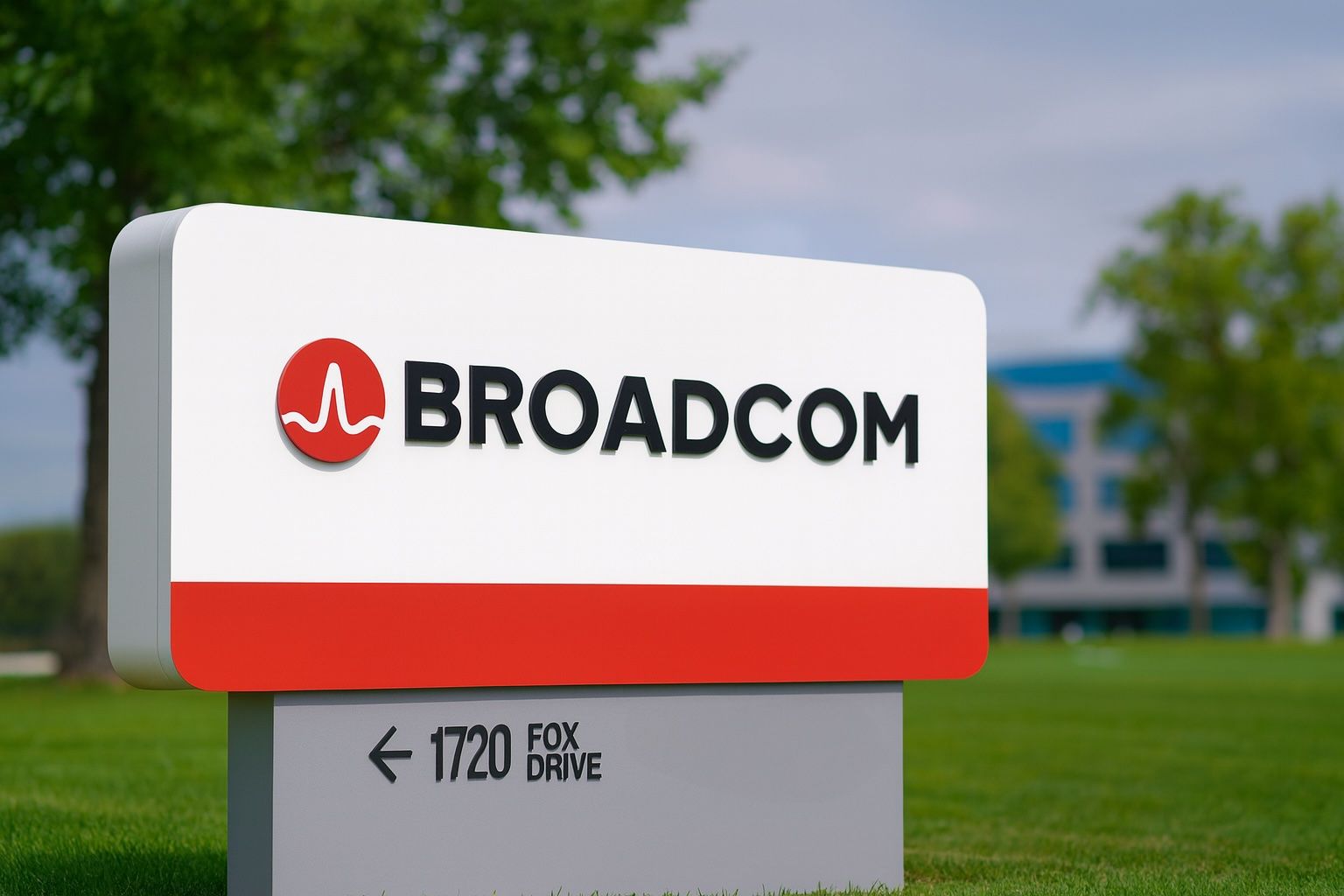- Soaring Stock & Trillion-Dollar Valuation: Broadcom Inc. (NASDAQ: AVGO) shares recently traded around $333, more than doubling over the past year, giving the company a market cap near $1.6 trillion [1] [2]. A 10-for-1 stock split in 2024 made shares more affordable, and year-to-date gains in 2025 are massive, fueled by the AI frenzy.
- Blowout Earnings on AI Demand:Fiscal Q3 2025 revenue hit a record $16.0 billion, up 22% year-over-year, as Broadcom’s AI semiconductor sales surged 63% to $5.2 billion [3]. Networking chip demand (e.g. new Tomahawk 6 switches) and software growth from VMware helped Broadcom beat forecasts [4]. Free cash flow jumped to $7.0 billion in the quarter [5].
- $10 Billion Custom-Chip Order (OpenAI): Broadcom revealed a blockbuster $10 billion order from a mysterious new cloud customer – widely believed to be OpenAI – for custom AI chips [6] [7]. CEO Hock Tan says this deal will make AI-related sales “improve significantly” in fiscal 2026 [8]. The company is co-developing a bespoke AI accelerator with OpenAI for 2026, signaling a deeper partnership [9] [10].
- AI Boom Meets Software Synergy: Broadcom’s semiconductor division is booming on AI – from Google’s TPU chips (100% share via Broadcom through 2026) [11] to Meta’s MTIA AI chips – while its software division (bolstered by the $69B VMware acquisition) provides steady, high-margin revenue. Broadcom is integrating AI capabilities into VMware Cloud Foundation 9.0 to help enterprises deploy private AI clouds [12].
- Investor Confidence & Leadership Stability: Legendary CEO Hock Tan (age 73) just extended his tenure by 5 years, reassuring investors [13] [14]. Tan’s aggressive M&A playbook and focus on cash flow have transformed Broadcom into a diversified tech giant. The company even raised $5 billion in new debt to refinance and fund growth [15], signaling confidence in its outlook.
- Analysts: “Strong Buy” on AI Upside: Wall Street is overwhelmingly bullish – 26 analysts just raised estimates, and KeyBanc hiked its price target to $420 with an Overweight rating [16] [17]. Mizuho Securities calls Broadcom the “king of AI custom chips,” reiterating Outperform with a $410 target [18]. Consensus 12-month targets hover around the mid-$300s [19], but some see much more upside as Broadcom’s AI pipeline (now 7 big chip customers) expands [20].
- Competitive Edge and Risks: Broadcom’s behind-the-scenes role in AI sets it apart – it supplies custom AI ASICs to hyperscalers like Google, Meta, and (soon) OpenAI [21] [22], addressing bottlenecks that off-the-shelf Nvidia GPUs can’t [23]. However, reliance on a few large customers is a double-edged sword [24] [25]. Big tech firms have a history of developing in-house chips to cut costs – for example, Apple is designing its own iPhone wireless chips to replace Broadcom’s by 2025-2026 [26]. Broadcom must continue innovating to stay indispensable.
- Showdown With Chip Rivals:Nvidia still dominates with ~80–90% market share in AI accelerators [27], but Broadcom is muscling in with custom silicon. AMD just struck a landmark deal to supply OpenAI with GPUs, a multi-year pact worth “tens of billions” annually (including an option for OpenAI to take a 10% stake in AMD) [28] [29] – underscoring intense competition. Qualcomm, meanwhile, targets on-device AI; its Cloud AI 100 chip even outperformed Nvidia on certain efficient inference tasks [30]. Broadcom’s strategy is to “connect everything” – combining networking, specialty silicon, and software – to carve out a defensible niche beyond just chips.
OpenAI’s pursuit of custom AI hardware has led it to Broadcom for chip design collaboration, aiming to reduce reliance on Nvidia. Broadcom’s CEO confirmed a huge $10 billion order from a new cloud client (believed to be OpenAI), catalyzing investor excitement [31] [32].
Broadcom’s Financial Surge Amid the AI Gold Rush
Broadcom is riding a wave of unprecedented demand for AI infrastructure, translating into stellar financial results. In its Q3 FY2025 earnings, Broadcom reported record revenue of $16.0 billion, a +22% YoY jump, handily beating estimates [33]. Net income and cash flows are robust – free cash flow hit $7.0 billion in the quarter [34] – reflecting both the high margins of its chip business and the steady cash generation of its enterprise software arm. Importantly, AI-centric products are the growth engine: Broadcom’s AI semiconductor revenue reached $5.2 billion in Q3 (up 63% YoY) [35], accounting for roughly one-third of total sales. CEO Hock Tan highlighted that custom AI accelerators, networking gear, and VMware software together drove the record results [36].
This momentum shows no signs of slowing. Broadcom guided for Q4 (ending in October 2025) revenues around $17.4–17.5 billion, ahead of consensus [37] [38]. Tan noted that AI chip demand is accelerating – Q4 AI revenue is forecast at $6.2 billion, up sequentially from Q3 [39] – and that customers are “strongly investing” in AI despite macroeconomic concerns. The company has now notched 10 consecutive quarters of double-digit annual sales growth, and AI has been a common thread throughout that streak [40].
Broadcom’s financial performance also benefits from operational focus. Gross margins and operating margins remain high, as Broadcom emphasizes selling high-value, specialized chips (like network switches, custom ASICs, and RF modules) rather than commodity components. Its operating model – fabless design with outsourced manufacturing (mostly to TSMC) – keeps capital expenditures relatively low for a company of its size. In 2024, even before the latest surge, Broadcom delivered 43.99% revenue growth (boosted by the VMware deal) while prioritizing shareholder returns [41]. It’s noteworthy that FY2024 earnings dipped (due to one-time charges and integration costs [42]), but underlying EPS growth is expected to resume as cost synergies from VMware kick in and AI chip sales scale up.
AI Chips: Broadcom’s $10B Jackpot and Custom Silicon Strategy
The headline-grabbing news for Broadcom has been its deepening foray into AI chips. On Broadcom’s latest earnings call, Hock Tan revealed that a “new cloud customer” placed a massive $10 billion order for AI infrastructure ASICs (application-specific chips) – widely understood to be OpenAI [43]. OpenAI, maker of ChatGPT, has been seeking to develop its own AI accelerators to reduce dependence on Nvidia, and reports confirm OpenAI is co-designing a custom AI chip with Broadcom for launch in 2026 [44] [45]. In fact, Broadcom’s CEO noted this mystery $10B order in tandem with securing over four new ASIC customers, strongly hinting OpenAI is one of them [46] [47]. According to Reuters, Broadcom has already qualified this new client’s order, adding the customer to its roster of hyperscale partners [48].
This OpenAI deal is a huge validation of Broadcom’s strategy. By working hand-in-hand with hyperscalers (cloud giants), Broadcom designs tailored AI chips – often called XPUs or ASICs – that are pre-programmed for specific AI workloads [49] [50]. Unlike general-purpose GPUs, these custom chips can be more efficient for their target tasks (like large language model training or inference), albeit less flexible [51]. Broadcom’s playbook, as described by Motley Fool analysts, is to “leverage its deep IP library” in areas like networking, interconnects, and security to craft chips alongside a select few big clients [52]. It has done this successfully with Google (for Google’s TPU chips that power its cloud AI – Broadcom was an early partner in TPU development) [53], with Meta (design wins for Meta’s in-house AI chip MTIA) [54], and even with China’s ByteDance (TikTok’s owner, also investing in AI silicon) [55].
OpenAI’s partnership extends that list and is arguably the most high-profile yet. Industry experts note this “bold move challenges Nvidia’s dominance” in AI hardware [56]. By 2027, Broadcom estimates just its first three custom-chip customers (Google, Meta, ByteDance) could represent a $60–90 billion opportunity [57] – an astonishing figure considering Broadcom’s total revenue this year will be about $63 billion. Now with a fourth major customer (OpenAI) on board, the future revenue potential could be even higher. Tan stated that AI revenue growth will only accelerate further in FY2026 thanks to these engagements [58].
However, Broadcom’s reliance on a handful of mega-clients comes with concentration risk. The biggest risk to the stock, analysts warn, is that losing even one major customer – or facing pricing pressure from them – could dent growth [59] [60]. Broadcom’s leadership is well aware of this. It’s why Tan famously keeps Broadcom’s R&D tightly aligned with key customer roadmaps, essentially embedding Broadcom’s engineers with partners. This approach creates high switching costs (Broadcom becomes integral to a partner’s AI strategy), but it’s not foolproof. Big tech firms have deep pockets and incentives to develop their own silicon if it saves money long term. For instance, Apple – which contributes an estimated ~20% of Broadcom’s revenue via iPhone wireless chip purchases – is developing its own wireless/Bluetooth chips. In fact, Apple already replaced one Broadcom Wi-Fi/Bluetooth component with an in-house chip in recent iPhones [61], and by 2025-2026 Apple’s custom solution could largely displace Broadcom in that slot. Similarly, Alphabet (Google) at one point sourced cheaper Wi-Fi chips from Synaptics, cutting Broadcom out [62]. These examples outside of AI show the pattern: if Broadcom’s offerings become too costly or if IP leaks, giants will seek alternatives.
So far, Broadcom is staying indispensable by pushing the innovation envelope. A great example is its work on co-packaged optics (CPO) – essentially blending optical fibers directly with switching chips to massively boost data speeds and efficiency for AI data centers. In early October, Broadcom announced it achieved one million hours of error-free operation on its CPO 400G optical ports during testing at Meta’s lab [63] [64]. This milestone (no “link flaps” or drops over a million cumulative port-hours) demonstrates that Broadcom’s CPO tech is reliable at scale [65] [66]. It’s a big deal because AI supercomputers need both high compute power and ultra-fast interconnects. Broadcom’s Tomahawk 6 switch chip, launched mid-2025, doubles throughput to 51.2 Tb/s to alleviate AI cluster bottlenecks [67] – and when paired with CPO modules, it can slash power usage by ~65% versus traditional pluggable optics [68]. Industry analysts note Broadcom’s unique position here: while Nvidia sells GPUs and networking (after acquiring Mellanox), Broadcom is providing the “plumbing” – the network fabric and custom accelerators – that tie AI systems together [69] [70]. This behind-the-scenes role isn’t as flashy as selling GPUs, but it’s immensely valuable and somewhat insulated from direct consumer scrutiny.
Broadcom’s Expanding Software Empire: VMware and Beyond
Beyond semiconductors, Broadcom has built a parallel empire in enterprise software, now roughly 40%+ of revenue [71]. This strategy started with acquisitions of CA Technologies (mainframes) and Symantec’s enterprise security division in 2018-2019, and culminated in the massive $61 billion VMware takeover (closed in late 2023). The rationale: diversify into infrastructure software that provides recurring license and support revenues, smoothing out the cyclical chip business. Thus far, it’s working. In Q3, Broadcom’s Infrastructure Software segment delivered $6.8 billion in sales, up a solid +17% YoY [72], contributing over 40% of total company revenue. VMware’s cloud and virtualization portfolio is now Broadcom’s crown jewel on the software side.
Importantly, Broadcom is actively integrating AI features into its software offerings, creating synergy between the hardware and software businesses. A recent example is VMware Cloud Foundation 9.0 (the data center virtualization platform) which Broadcom updated to support “AI-native” infrastructure [73]. This allows Broadcom to sell a one-stop solution to enterprise and telco customers: cutting-edge Broadcom silicon (switches, accelerator chips, NICs) underneath, and VMware’s software on top orchestrating secure, private AI clouds. Analysts have praised this focus on secure, on-premise AI deployments for big corporations [74] – a market that wants AI benefits but with control over data and compliance. Broadcom’s unique mix of assets (chips + software) positions it well to meet that need. The partnership ecosystem around VMware is also growing: Broadcom cites collaborations with AMD, Intel, NVIDIA, and Canonical (Ubuntu Linux) to ensure its software runs optimally on various hardware and cloud environments [75].
Of course, digesting a $61B acquisition isn’t trivial. Broadcom has a track record of aggressively wringing efficiencies out of acquisitions (often by cutting costs and focusing on top customers), and it’s doing the same with VMware. One overhang was a legal issue Broadcom inherited: VMware faced a class-action lawsuit alleging it misled investors about sales backlogs in 2018-2020. In late 2024, VMware (by then about to be owned by Broadcom) agreed to a $102.5 million settlement to resolve those claims [76]. Final approval of that settlement came in March 2025 [77]. While $102.5M is a drop in the bucket for Broadcom, clearing this out helped remove a cloud over VMware’s reporting credibility [78]. Broadcom can now integrate VMware without that baggage.
Looking ahead, Broadcom’s software strategy is to continue focusing on big clients and mission-critical infrastructure (much like its chip strategy). It has pledged to keep investing in VMware’s core products (vSphere, vSAN, NSX, etc.) and maintain support for multi-cloud deployments. Some VMware customers were initially nervous about the acquisition, fearing price hikes or reduced support, but Broadcom has been actively engaging the community and even launched programs like “Broadcom Knights” – an elite group of partner engineers across its software divisions (including VMware) who help customers with deep technical expertise [79] [80]. As a result, more enterprises are warming up to Broadcom as a long-term software partner. The recurring revenue from multi-year VMware licenses and subscriptions is now flowing into Broadcom’s coffers, improving visibility. In short, Broadcom’s business model has evolved: it’s no longer just a chip supplier, but a hybrid hardware-software powerhouse serving the full stack of modern IT infrastructure.
Market Sentiment: Experts Weigh In
Wall Street and industry experts have taken note of Broadcom’s transformation. Financial pundits and tech analysts largely agree that Broadcom is one of the biggest winners of the AI revolution – albeit a somewhat under-the-radar one compared to Nvidia. “There are so many good semiconductor companies out there,” exclaimed CNBC’s Jim Cramer recently, urging investors to “go with Broadcom” over smaller chip names [81]. The rationale: Broadcom offers both growth (from AI and cloud) and stability (from diversified products and enterprise software) – a combination that’s rare in the volatile chip sector.
Analysts are particularly enthusiastic about Broadcom’s AI prospects. KeyBanc Capital Markets just raised Broadcom’s price target to $420 and reiterated an Overweight rating ahead of Broadcom’s next earnings, citing “robust AI demand in networking and ASICs” as a driver [82] [83]. KeyBanc’s analysts expect Broadcom’s upcoming results to beat consensus and for management to issue stronger guidance into 2026 on the back of AI tailwinds [84]. They highlighted that Broadcom has some AI monopolies – for instance, Broadcom is expected to maintain 100% share of Google’s TPU supply through 2026 [85] – and that Meta’s new AI chip (MTIA v2) ramp will further boost Broadcom’s chip revenues [86]. The $10B OpenAI order is another focal point; analysts are eager for details on timing and margins for that deal [87]. Notably, a concern had circulated that such large “AI supercomputer” deals might be low-margin (essentially pass-through hardware sales). But Mizuho Securities addressed this, noting that Broadcom will pass on the costs for AI systems without “margin stacking,” preserving its profitability [88]. Mizuho calls Broadcom a leader in CoWoS (chip-on-wafer-on-substrate) packaging supply for AI and affirms that Broadcom is a core AI beneficiary, not just a peripheral player [89].
Outside of AI, Broadcom’s steady dividend and cash returns also earn praise. The stock yields around 2.2% and Broadcom is known for regular dividend hikes (though none were announced at the last report). This makes it somewhat of a hybrid growth-and-income stock, unusual in tech. As a result, market sentiment has been very positive. Broadcom’s stock is up ~+110% year-on-year [90] (after adjusting for the 10:1 split), outpacing the S&P 500 and even many pure-play AI stocks. In fact, Broadcom was recently named among “the 10 strongest-performing mega-cap stocks of 2025” [91] by Forbes, joining the likes of Nvidia and Oracle. However, some caution that after such a run, valuation is a consideration. Broadcom’s forward P/E ratio hovers around 38, which is higher than Nvidia (~33) or AMD (~30) and well above TSMC (~27) [92] [93]. This premium reflects investors pricing in Broadcom’s resilient business model – but it also leaves less room for error. MarketWatch recently noted that momentum stocks like Broadcom could be “especially risky now” if the market turns, given how much optimism is baked into the price [94].
Overall, the sentiment can be summed up by a recent Insider Monkey/Yahoo Finance piece dubbing Broadcom “the non-Nvidia winner” among chip designers [95]. Broadcom doesn’t grab headlines like GPU-maker Nvidia, but it has steadily amassed an empire that “connects everything” in the digital world – from the mobile phone in your pocket (Broadcom chips handle Wi-Fi, Bluetooth, and RF in many iPhones) to the data center switching fabric enabling AI supercomputers, to the software running mission-critical applications for banks and governments. This breadth, combined with sharp execution, has made Broadcom one of 2025’s most compelling tech stories.
Broadcom vs. The Competition: Divergent Paths in a Booming Market
In the semiconductor arena, Broadcom’s most direct competitors include Nvidia, AMD, Qualcomm, and to some extent Intel – but each of these companies is taking a different path in the evolving chip landscape:
- Nvidia – the undisputed leader in AI chips today – focuses on powerful general-purpose GPUs and a rich AI software ecosystem (CUDA). Nvidia’s ~80-90% market share in AI accelerators stems from this one-stop solution approach [96]. Broadcom, in contrast, is not trying to sell the next GPU to every AI startup; instead it’s partnering on bespoke solutions for the top cloud players. This makes Broadcom more of a “silent partner” in the AI boom. Notably, many Nvidia GPU deployments still rely on Broadcom’s technology: e.g., Nvidia’s HGX AI servers often use Broadcom’s switches and NICs for connectivity, and Nvidia itself is a major customer of TSMC’s CoWoS packaging where Broadcom has expertise [97]. Still, Nvidia’s success is a double-edged sword – it expands the AI pie for everyone, but also poses a risk if Nvidia ever encroaches on custom ASIC territory. So far, Nvidia has stayed focused on GPUs and DPUs, leaving custom AI ASICs largely to others.
- AMD – historically a CPU and GPU maker – has aggressively positioned itself as an alternative to Nvidia. AMD’s latest MI300 series GPU accelerators target AI training and inference, and the company just scored a game-changing win: on Oct 6, 2025, AMD announced a multi-year deal to supply OpenAI with hundreds of thousands of AI GPUs [98]. This deal, which sent AMD stock skyrocketing +34% in one day [99], could generate $100+ billion in new revenue for AMD over a few years [100] [101]. Intriguingly, OpenAI’s strategy is not either/or but both – it’s working with Broadcom on custom chips and buying standard GPUs from AMD (and likely still Nvidia), ensuring a multi-source supply. Broadcom’s advantage over AMD is that it’s deeply integrated into OpenAI’s chip design process, potentially locking in longer-term exclusivity on that custom silicon. AMD, however, brings ready-to-deploy GPU capacity, which OpenAI needs immediately. In essence, AMD and Broadcom are capturing different slices of OpenAI’s spend – one via off-the-shelf GPUs, the other via co-developed chips for future needs. Broadcom also collaborates with AMD in other ways (the two companies share some customers, and Broadcom’s chips can be found on AMD-powered systems), so it’s a complex coopetition. The takeaway: AMD’s win underscores booming AI demand, but doesn’t diminish Broadcom’s role – if anything, it validates that cloud firms will invest tens of billions in AI hardware, leaving room for multiple suppliers.
- Qualcomm – best known for smartphone processors and modems – is pursuing AI more on the edge computing side. Qualcomm’s flagship Snapdragon chips now boast beefy AI accelerators to run generative AI models on devices (Qualcomm claims its latest phone chips can run 30+ AI models on-device, including image and text generation) [102]. It also developed the Cloud AI 100 inference chip for data centers, which in tests showed better queries-per-watt efficiency than Nvidia GPUs for certain tasks [103]. Broadcom overlaps with Qualcomm primarily in networking and wireless chips. Notably, Apple’s move to insource chips threatens both Qualcomm (modems) and Broadcom (RF/Wi-Fi) in iPhones [104]. While Qualcomm’s approach to AI is to embed it everywhere (phones, IoT, autos), Broadcom’s is to power the infrastructure behind AI. They rarely compete head-to-head for AI accelerator deals. In 5G and Wi-Fi chips, Broadcom actually exited the handset RF front-end business (it sold certain wireless chip lines in past years) to focus on more profitable niches, effectively ceding some ground to Qualcomm. Thus, in the AI era, Qualcomm is carving out an “on-device AI” niche, whereas Broadcom thrives in data center AI. Both see growth, but Broadcom’s market (cloud spending) is currently the more explosive one.
- Intel – the CPU giant – is also in the mix with its Gaudi AI accelerators (acquired from Habana Labs) and it still dominates data center CPUs that pair with Broadcom’s chips. Intel’s Gaudi2 has touted better price-performance than some Nvidia GPUs in specific workloads [105] [106]. However, Intel is in the midst of a turnaround and isn’t yet a major threat in AI accelerators. Broadcom, interestingly, benefits no matter which CPU is used (its NICs and switches are CPU-agnostic), and it isn’t directly pitted against Intel in most deals.
Finally, one cannot ignore the cloud titans themselves as “competitors.” Companies like Google, Amazon, Meta are designing more of their own silicon (TPU, AWS Trainium/Inferentia chips, Meta’s MTIA etc.) [107]. Broadcom smartly treats these not as adversaries but as customers. By assisting them in custom chip development, Broadcom makes revenue where others might see lost opportunity. It’s a coopetition model that requires trust and IP safeguards. If Broadcom can continue to be the partner of choice for custom silicon (essentially a semiconductor arm for hire to the giants), it will maintain a unique stronghold in the industry.
Outlook: Short-Term Catalysts and Long-Term Trajectory
In the short term, all eyes are on Broadcom’s upcoming earnings (fiscal Q4 2025), expected in December. Investors will be watching for updates on the OpenAI deal timeline, backlog levels, and how much of the $10B order will hit 2026 revenues. Any upside in Q4 results – e.g. if AI chip sales beat the $6.2B guidance – could further juice the stock. Conversely, since Broadcom’s shares have run up so far, any hint of slowing momentum (say, a push-out of orders or softer Q1 2026 guidance) could cause a pullback. The volatility in the broader market is also a factor; high-valuation tech stocks have been whipsawing on interest rate news and other macro factors, and Broadcom is not immune to that.
That said, Broadcom enters 2026 with substantial tailwinds. Its order book for AI infrastructure exceeds $25 billion (including the new OpenAI order) stretching over the next year-plus [108]. Cloud capital expenditures by the likes of Google, Microsoft, Amazon, Meta, etc. are forecast to keep rising to meet AI demand – and Broadcom has content in many of the devices those dollars will buy. The company’s seven ASIC/“XPU” projects in the pipeline (as hinted by KeyBanc [109]) could translate to multiple design wins beyond the known four. In networking, Broadcom’s dominant share in data center Ethernet switches (>50% share of switch silicon) and NICs means it will also gain from the general growth of AI clusters (which require tons of advanced networking). On the software side, VMware’s growth – albeit slower than chips – provides stability and upsell opportunities (e.g. cross-selling security software or mainframe tools to VMware’s installed base). There’s also potential for future M&A: Hock Tan is known for acquisitive tendencies, and with Broadcom’s cash generation, it could pursue another big software acquisition in coming years (some speculate targets like SAS Institute or even parts of IBM, though nothing concrete). For now, Tan has said Broadcom is focused on integrating VMware through 2025 before any new huge deals.
Long term, analysts forecast Broadcom’s earnings to keep climbing in double digits as AI investment continues. Some projections see AVGO’s EPS doubling by 2028 if AI, networking, and software trends remain favorable. The company’s approach of targeting “secular growth” areas (AI, 5G, cloud, enterprise digitization) means it is aligned with where IT spending is heading. The key will be execution and navigating competitive/partner dynamics. But given Broadcom’s track record – transforming itself from a commodity chip supplier a decade ago into a tech conglomerate at the center of multiple high-growth trends – many are betting it will successfully manage the challenges.
In summary, Broadcom in late 2025 finds itself in a sweet spot: It’s supplying critical technology to the world’s AI superpowers, enjoying record financial performance, and earning accolades from investors and customers alike. Yet it’s also entering a stage of heightened expectations. The stock’s surge implies that Broadcom must keep delivering high growth to justify its valuation. The competitive landscape is intensifying, with rivals and customers sometimes one-upping each other (and potentially Broadcom) in the race for AI supremacy. Broadcom’s mix of bold strategic bets (like the OpenAI partnership), engineering prowess (custom chips, CPO), and diversified portfolio gives it a strong hand. As the AI revolution and digital transformation march forward, Broadcom has firmly positioned itself as a foundational player “connecting everything” – from silicon to software – in our connected, intelligent future. Investors and analysts will be watching closely to see if it can continue to execute on this grand vision.
Sources: Broadcom investor news and earnings data [110] [111]; Reuters, Yahoo Finance and Motley Fool reports on Broadcom’s AI chip deals, financial results, and analyst commentary [112] [113] [114]; TradingView/11thestate insight on VMware integration and legal settlement [115] [116]; CNBC/Benzinga (Jim Cramer) [117]; TS2/Tech Space 2.0 news roundups on Broadcom’s AI surge and OpenAI partnership [118] [119]; Reuters coverage of AMD’s OpenAI deal and market impact [120] [121]; SDX Central on Broadcom’s co-packaged optics breakthrough with Meta [122] [123]; Nasdaq/Insider analysis of Broadcom’s competitive positioning and risks [124] [125]; market data from Yahoo/CompaniesMarketCap [126].
References
1. www.investing.com, 2. macrotrends.net, 3. www.nasdaq.com, 4. ts2.tech, 5. futurumgroup.com, 6. www.nasdaq.com, 7. ts2.tech, 8. ts2.tech, 9. www.nasdaq.com, 10. ts2.tech, 11. www.investing.com, 12. www.tradingview.com, 13. ts2.tech, 14. ts2.tech, 15. www.investing.com, 16. www.investing.com, 17. www.investing.com, 18. www.investing.com, 19. stockanalysis.com, 20. www.investing.com, 21. www.nasdaq.com, 22. www.nasdaq.com, 23. ts2.tech, 24. www.nasdaq.com, 25. www.nasdaq.com, 26. www.nasdaq.com, 27. ts2.tech, 28. www.reuters.com, 29. www.reuters.com, 30. ts2.tech, 31. ts2.tech, 32. www.nasdaq.com, 33. ts2.tech, 34. futurumgroup.com, 35. futurumgroup.com, 36. futurumgroup.com, 37. ts2.tech, 38. www.investing.com, 39. futurumgroup.com, 40. futurumgroup.com, 41. stockanalysis.com, 42. stockanalysis.com, 43. www.nasdaq.com, 44. www.nasdaq.com, 45. ts2.tech, 46. www.reuters.com, 47. www.nasdaq.com, 48. www.reuters.com, 49. www.nasdaq.com, 50. www.nasdaq.com, 51. www.nasdaq.com, 52. www.nasdaq.com, 53. www.nasdaq.com, 54. www.nasdaq.com, 55. www.nasdaq.com, 56. ts2.tech, 57. www.nasdaq.com, 58. ts2.tech, 59. www.nasdaq.com, 60. www.nasdaq.com, 61. www.nasdaq.com, 62. www.nasdaq.com, 63. www.investing.com, 64. www.sdxcentral.com, 65. www.sdxcentral.com, 66. www.sdxcentral.com, 67. www.nasdaq.com, 68. www.investing.com, 69. stockanalysis.com, 70. stockanalysis.com, 71. futurumgroup.com, 72. futurumgroup.com, 73. www.tradingview.com, 74. www.tradingview.com, 75. www.tradingview.com, 76. www.tradingview.com, 77. www.tradingview.com, 78. www.tradingview.com, 79. news.broadcom.com, 80. news.broadcom.com, 81. www.benzinga.com, 82. www.investing.com, 83. www.investing.com, 84. www.investing.com, 85. www.investing.com, 86. www.investing.com, 87. www.investing.com, 88. www.investing.com, 89. www.investing.com, 90. appreciatewealth.com, 91. stockanalysis.com, 92. finviz.com, 93. finviz.com, 94. stockanalysis.com, 95. finance.yahoo.com, 96. ts2.tech, 97. www.investing.com, 98. www.reuters.com, 99. www.reuters.com, 100. www.reuters.com, 101. www.reuters.com, 102. ts2.tech, 103. ts2.tech, 104. www.nasdaq.com, 105. ts2.tech, 106. ts2.tech, 107. ts2.tech, 108. www.reuters.com, 109. www.investing.com, 110. futurumgroup.com, 111. futurumgroup.com, 112. ts2.tech, 113. www.investing.com, 114. www.investing.com, 115. www.tradingview.com, 116. www.tradingview.com, 117. www.benzinga.com, 118. ts2.tech, 119. ts2.tech, 120. www.reuters.com, 121. www.reuters.com, 122. www.investing.com, 123. www.sdxcentral.com, 124. www.nasdaq.com, 125. www.nasdaq.com, 126. macrotrends.net







